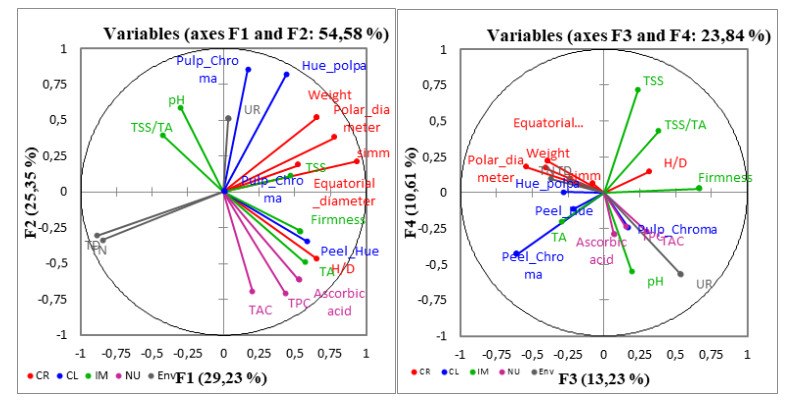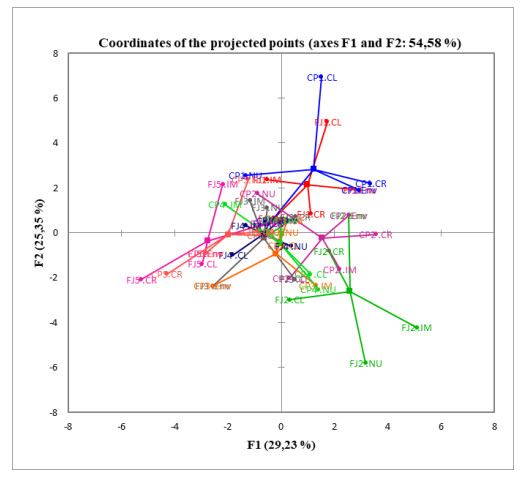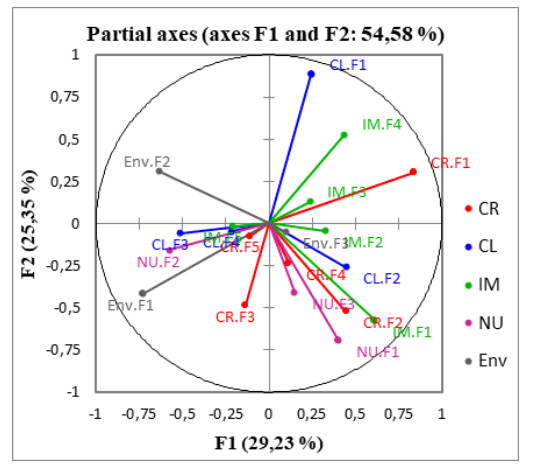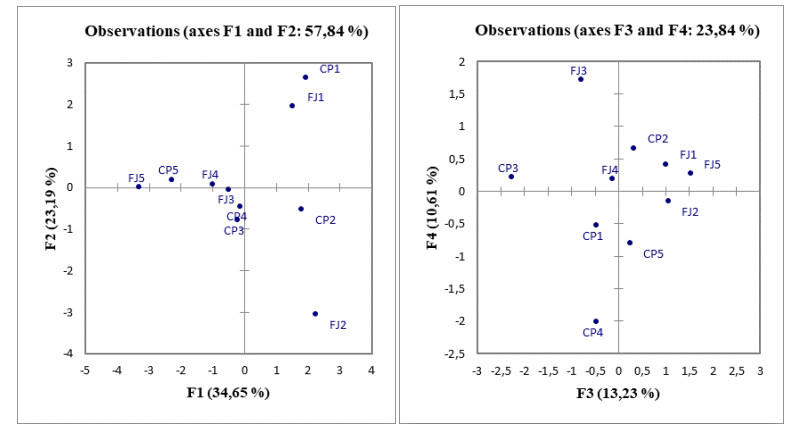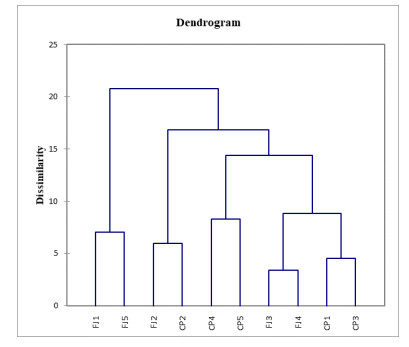This work aimed to analyse the differences between fruits obtained by different harvest dates in two cultivars Annona cherimola (Fino de Jete and Campas) planted in Southern Italy. The fruits selected at the fruit-set time were harvested when 1500 Degree Day were accumulated. Fruits were sampled from October to December when 1500 Growing Degree Days (DD) were accumulated from fruit-set. Fruit fresh weight and skin colour were measured at harvest and after storage. The following parameters were also measured: Fruit shape, pulp colour, pulp firmness, number of seeds, total soluble solids, titratable acidity, ascorbic acid, total polyphenol content, total antioxidant capacity and fruit dry weight. An MFA was carried out. In the first phase of the MFA, a PCA was performed for each group of quantitative variables (PPCA). Then, the variables were divided into five groups: Carpological (CR), colourimetric (CL), maturation index (MI), nutraceutical (NU), and Environmental (Env). All relations between the variables and the formation of the factors were affected. The multifactorial factor analysis has allowed evaluating the role that the different groups of variables, taken into consideration, have in defining the time harvest. In order to have fruits of regular shape and size, the harvest must be carried out within the last ten days of October, involving the pollinated flower within the third week of June. About the size and regularity of the fruit, from the third week of June, it appears to be borderline, as the fruits are smaller in size, with fewer seeds, but still, guarantee size and shape that falls within the quality standards of the Annona cherimola. Between the two cultivars, Fino de Jete cultivar is more sensitive to temperature increases during the pollination period than the Campas cultivar.
1.
Introduction
The major quality attributes of Cheddar cheese, flavor, texture, and aroma, evolve during the ripening (aging) of the cheese and reflect the combined manifestation of a very broad array of microbiological, biochemical and physico-chemical events [1,2,3,4,5,6]. The main biochemical cascades that are involved in the evolution of the cheese quality attributes are proteolysis, lipolysis and glycolysis [1,2,4,7]. In addition to their direct impact on the texture and flavor properties of the cheese, the products of the major biochemical cascades become involved in numerous of secondary catabolic reactions that further affect the evolution of cheese quality attributes [1,2,3,4,8,9]. Proteolysis is the most complex among the three major cascades and has been shown to have the most critical impact on the evolution of texture and flavor in cheeses such as Cheddar [1,2,3,4,5,6,7,8,9,10,11]. Proteolysis during cheesemaking and aging is governed by the combined influence of the proteolytic potential that is introduced into the milk and the curd during cheesemaking and aging as well as the effects of curd composition and aging conditions on the manifestation of this potential [2,4,12]. In the cases of Cheddar cheese, the proteolytic potential includes the indigenous proteolytic enzymes of milk, plasmin and cathepsin, the proteolytic enzymes originating from somatic cells and psychrotrophic bacteria, the coagulating enzyme, as well as the proteolytic enzymes of starter- and non-starter lactic acid bacteria [2,4,6,10,13,14,15,16,17,18,19,20,21,22,23]. The development of desired flavor and texture properties of Cheddar cheese has been strongly correlated with the type and extent of proteolytic activities during cheese aging [6,7,9,10,24,25,26]. The development of flavor profile and flavor intensity of Cheddar cheese has been correlated with the accumulation of small peptides and free amino acids (FAA) and, consequently, with the catabolism of FAA that yields different flavor- and aroma-impacting compounds [2,6,9,11,25,26,27,28,29]. The importance of proteolysis during cheese aging to the evolution of cheese quality attributes is reflected in the different proteolysis-related ripening indices that have been developed [30,31]. Such indices are based on the quantitative determination of the accumulation of different soluble N fractions [4,25,30,31]. These indices include the water-soluble cheese-N (WSN), the pH 4.6 soluble cheese-N (4.6SN), the12% tri-chloroacetic acid soluble cheese-N (12TCASN) and the 5% phospho-tungstic acid soluble cheese-N (5PTASN) [13,25,31]. The accumulation of free L-glutamic acid (L-Glu) has been indicated as a relevant and meaningful cheese ripening index [32]. The relationships between cheese quality attributes and the afore-mentioned critical role that proteolysis has in the development of cheese quality attributes suggest that, ideally, Cheddar cheese should be marketed according to its biochemical age. Such an approach has to be based on a series of selected quantitative cheese-quality-impacting parameters, such as the afore-listed ripening indices, that express the extent to which proteolysis has progressed during cheese aging. However, in practice, Cheddar cheese is marketed based on its chronological age using an approach that categorizes the cheese into "young", "medium", "sharp" and "extra-sharp". Inherent to this approach is the assumption that all Cheddar cheeses of a given chronological age carry similar flavor, aroma, and textural properties. Yet additionally, in light of the dependency of texture and flavor development in Cheddar cheese on the type and extent of proteolytic activities during aging (among other things), this marketing approach is based on an assumption that Cheddar cheeses of a given chronological age have similar proteolytic age. The term "similar proteolytic age" suggests a similar extent to which the caseins have been hydrolyzed enzymatically by the cascade of proteolytic events during cheese making and aging. Cheddar cheeses with a similar proteolytic age can therefore be expected to have a similar set of proteolysis-related ripening indices. Information about the proteolytic age of commercial Cheddar cheese of a given age almost does not exist [33,34,35]. Published research about the composition and quality attributes of retail full- and reduced/low-fat Cheddar cheeses from the UK and Ireland reveled both inter- and intra-cheese category differences in composition, extent of proteolysis, flavor and texture [36] The objective of our study was therefore to challenge these assumptions by investigating the proteolysis during aging of different commercial full- and reduced-fat Cheddar cheeses of an identical chronological age.
2.
Materials and methods
2.1. Cheeses
Seven full-fat (FF) and five reduced-fat (RF) Cheddar cheeses, 100 kg each (from a given manufacturing batch), were delivered to our laboratory (at 6–8 ℃) at a cheese age of 5–7 days. The cheeses were all manufactured, on the same day, by different large commercial creameries in CA and in the Mid-West. Upon arrival, the cheeses were portioned into 1 kg rectangular "blocks" that were then vacuum-packaged in BK1 Cryovac plastic bags (W.R. Grace Co., Duncan, SC). The packaged cheeses were aged for 180 days in a walk-in aging room that was maintained at 5 ± 1 ℃. The relative humidity in the aging room was maintained at 65 ± 5%.
2.2. Analyses
2.2.1. Cheese composition
The composition of the cheeses was investigated at a cheese age of 10 days using the analytical approaches that are described in the Standard Methods of analyzing milk and dairy products [37]. Protein content of the investigated cheeses was determined according to the macro-Kjeldahl method, using a nitrogen-to-protein conversion factor of 6.38 [37]. Fat content of the investigated cheeses was determined according to the Rose-Gotlieb method [37]. The moisture content of the cheeses was determined gravimetrically after 12 h of vacuum-drying [37]. The ash content of the cheeses was determined gravimetrically following incineration in a muffle oven at 550 ℃ [37]. The salt content of the cheeses was determined according to the Volhard procedure [37]. The parameter salt-in-moisture (S/M) was calculated according to Equation 1. The parameter fat-in-dry-matter (FDM) was calculated according to Equation 2. The parameter moisture-in-fat-free-substance (MFFS) was calculated according to Equation 3. The pH of the cheeses was determined using an Orion Star pH meter equipped with a spear-tip glass electrode (Thermo- Fisher Scientific). In all cases, duplicate cheese samples were analyzed in quadruplicate (n = 8).
Where: S/M, Sc, and M are salt in moisture (%), salt content in cheese (%), and moisture content, respectively.
Where: FDM (%), Fc (%) and M (%) are fat in dry matter, fat content of cheese, and moisture content of cheese, respectively.
Where: MFFS, Fc, and M are moisture in fat free substance (%), fact content of cheese (%) and moisture content of cheese (%), respectively.
2.2.2. Cheese-N fractionation
The progression of proteolysis during 180 days of cheese aging was investigated using a fractionation approach that allowed monitoring the accumulation of several cheese-N fractions that have been suggested as meaningful cheese ripening indices [6,13,30,31] as well as by following the accumulation of free L-glutamic acid (L-Glu) in the cheese [32].
The investigated cheese-N fractions included the cheese-N fraction that was soluble at pH 4.6 (4.6SN), the cheese-N fraction that was soluble in 12% tri-chloroacetic acid (12TCASN), and the cheese-N fraction that was soluble in 5% phospho-tungstic acid (5PTASN) [6,13,30,31]. The constituent cheese-N fractionation procedures were carried out as previously described [13]. Briefly, cheese samples were grated using a Cuisinart Food Processor equipped with a grating plate. A mixture of the grated cheese (200g) and 400 mL of de-ionized water (Millipore, 18.2 MΩ.cm) was homogenized for 3 min using a model 34BL97 Warning Blender (Dynamic Corp., New Hartford, CT) operated at maximum speed. After being stirred for 30 min at 25 ℃, the slurry was centrifuged for 20 min at 3000 X g, the separated supernatant was filtered through a layer of glass wool (Fisher Scientific, Fair Lawn, NJ) and the collected filtrate was denoted water-soluble N (WSN). The pH of the WSN was adjusted to pH 4.6 with 1.4 N HCl (Sigma Chemical Company (St. Louis, MO, USA) and was then centrifuged at 3000 X g for 20 min. The separated supernatant was filtered through a No 1 filter paper (Fisher Scientific, Fair Lawn, NJ) and the resulted filtrate was denoted pH 4.6-soluble N (4.6SN). In order to prepare the 12TCASN fraction, 45 mL of the 4.6SN fraction was mixed with 15 mL of 48% TCA (Sigma Chemical Co., St. Luis, MO), the mixture was incubated for 12 h at 25 ℃ and was then centrifuged (20 min at 3000 X g). The separated supernatant was filtered through No1 Whatman filter paper and the resulted filtrate was denoted 12%TCA-soluble N (12TACSN). For preparing the cheese N fraction that was soluble in 5% PTA, 50 mL of the 4.6SN fraction was mixed with 3.95 mL of H2SO4 and 15 mL of 33.3% (w/w) PTA (Sigma Chemical Co. St. Luis, MO). The mixture was incubated for 12 h at 25 ℃, was then centrifuged at 3000 X g for 20 min, then, the separated supernatant was filtered through a No1 Whatman filter paper and the resulted filtrate was denoted as 5%PTA-soluble N fraction (5PTASN). In all cases, the N content of the extracted fractions was determined by the macro-Kjeldhal analysis and the results were expressed as percent of total cheese N. In all cases, duplicate samples were analyzed in triplicates (n = 6).
2.2.3. Accumulation of free L-Glu
The accumulation of L-Glu was determined as previously described [32]. Briefly, a sample (10 mL) of the afore-described WSN fraction was mixed with 150 mL of de-ionized water (Millipore, 18.2 MΩ.cm) at 70 ℃ and the mixture was allowed to reach 25 ℃. Then, the volume of the mixture was adjusted to 250 mL with de-ionized water, and the mixture was cooled to 4 ℃ in an ice bath. The cold mixture was filtered through a No 1 Whatman paper and the filtrate was investigated for its L-Glu content using a commercial enzymatic test kit (Boehringer Mannheim Biochemica Co., Mannheim, Germany) as previously reported [32]. In all cases, duplicate samples were analyzed in triplicate (n = 6).
2.2.4. Statistical Analysis
The significance of the results was tested at p < 0.05 by ANOVA using the SigmaStat software (Jandel Scientic Software, San Rafael, CA).
3.
Results and discussion
3.1. Cheese composition
The composition of the investigated FF and RF Cheddar cheeses is depicted in Table 1. The total solids content of the FF and RF cheeses ranged from 61.63 to 64.92% and from 50.53 to 56.43% for FF and RF cheeses, respectively, thus meeting the legal compositional requirement in FF and RF Cheddar cheese [38]. The moisture in fat-free solids (MFFS) content of the FF cheeses ranged from 54.00 to 56.9% (Table 1), it was higher than that reported by Guinee et al., in 2008 [35] and by Fenelon et al. [36], however, it was similar to what had been reported earlier by Guinee et al. [39]. The (MFFS) content of the RF cheeses ranged from 53.03 to 60.80% (Table 1) and was slightly higher than that reported earlier [36]. The FDM content of the FF cheeses was higher than 50%, as required by the regulation in the USA [38] and was similar to that reported by Guinee et al. [35] and by Fenelon et al. [36]. The fat content of the RF cheeses was at least 25% lower than that in FF Cheddar, thus meeting the legal compositional requirement for the term "reduced fat" [40]. The evolution of cheese quality attributes, such as flavor, aroma, texture, and functionality, represents the combined results of biochemical, microbiological and physico-chemical events that, among other things, are influenced by the combined influence of pH, S/M, FDM, water activity (aw), and MFFS [3,24,33,41]. The quality of aged Cheddar cheese has been shown to be significantly affected by the pH, S/M, FDM, and MFFS of the young cheese (10-30 days) [3,33,42]. In all but two cases (FF3 and RF1), the S/M content of the cheeses was higher than 4% and lower than 6% and was therefore within the S/M concentrations range that had been recommended for proper aging of Cheddar cheese [41,43,44]. The S/M content of the cheese has a significant effect on microbiological activities in the cheese during aging as well as on the autolysis of bacteria in the cheese during aging [41,44]. At early stages of the aging, the S/M influences the fermentation of residual lactose into lactic acid while at later stage it has a major effect on the propagation and activity of non-starter-lactic acid bacteria (NSLAB) as well as on the autolysis of bacteria that releases microbial enzymes into the curd [41,44]. It has been demonstrated that at S/M > 6, the fermentative activity of LAB is arrested [41,44]. The FF cheeses exhibited only small differences in their pH that ranged from 5.10 to 5.18 while the pH of the RF cheeses ranged from 5.10 to 5.23 (Table 1). The composition of the investigated FF Cheddar cheeses was very similar to that of the commercial Cheddar cheeses that were investigated by McCarthy et al. [33].
3.2. Proteolysis during aging
The proteolytic cascade that occurs during cheese aging has a profound influence on the evolution of the cheese quality attributes [2,4,6]. Investigating cheeses of identical chronological age that were ripened at identical aging conditions allowed highlighting the effects of the inherent compositional properties of these cheeses on the proteolytic cascade during aging. Proteolysis was investigated by monitoring, for 6 months, the accumulation of specific cheese N-fractions that have been indicated as cheese aging indexes as well as by investigating the accumulation of free L-Glu in the cheeses [25,32,45]. Results (Tables 2–10) indicated significant among-cheeses differences in the rate and extent of proteolysis during aging (p < 0.05).
3.2.1. The accumulation of pH4.6SN (4.6SN)
The pH4.6SN fraction of cheese contains a very heterogeneous mixture of peptide with a MW < 10kDa and free amino acids [6]. The ratio of 4.6SN to total N content has been indicated as a meaningful cheese ripening index representing the overall extent of proteolysis [5,6,39,46]. Results (Table 2) indicated a significant continuous increase (p < 0.05) in the proportion of the 4.6SN fraction that accumulated in the FF and RF cheeses during aging. In all cases (Table 3), the accumulation of the 4.6SN fraction during cheese aging could be described by second order polynomial expressions (R2 = 0.9721 − 1.000). Both FF and RF cheeses exhibited significant among-cheeses differences in the accumulation of the 4.6SN fraction (p < 0.05). For example, after 180 days of aging, the highest level of 4.6SN among the FF cheeses was exhibited by FF2 and was 1.17 times higher than that in the FF7 cheese. Similarly, the 4.6SN level in the RF1 cheese was 1.12 times higher than that in the RF5 cheese (Table 2). At cheese age of 30, 60, 90 and 180 days, the average level of 4.6SN in FF cheeses was 9.49, 12.69, 15.31, and 19.88%, respectively, while that in the RF cheeses was 8.79, 12.42, 15.19, and 20.37%, respectively. After 60 aging days, the level of the accumulated 4.6SN fraction in the FF and RF cheeses was 1.16–1.55 and 1.14–1.59 times higher than that after 30 aging days, respectively (Table 2). After 180 aging days, the level of the 4.6SN fraction that accumulated in the FF and RF cheeses was 1.78–2.35 and 1.96–2.56 times higher than that after 30 aging days, respectively (Table 2). The among-cheeses differences in the accumulation of the 4.6SN fraction indicated significant among-cheeses differences (p < 0.05) in the extent of proteolysis throughout the aging process. These results could be attributed to among-cheeses differences in their inherent proteolytic potential as well as to the influence of cheese composition on the manifestation of the proteolytic potential [2,4,6,8]. The changes, with aging time, in the accumulation of the 4.6SN fraction (Table 3) reflected the dynamic balance between the accumulation of proteolytic products and their involvement in catabolic reactions [2,4,6,9]. In addition to the information that is presented in Table 3, indications for variations in this balance during aging were provided by comparing the rate at which this fraction accumulated at different stages of the aging process. Results (Table 2) indicated that during the second, third, and last 3 months of aging, the change in the level of the 4.6SN per day in FF cheeses ranged from 0.062 to 0.159 %/d, from 0.042 to 0.152 %/d, and from 0.035 to 0.067%/d, respectively. Similarly, in the case of the RF cheeses, these changes ranged from 0.051 to 0.158%/d, from 0.067 to 0.120%/d and from 0.037 to 0.177%/d, respectively. In general, the accumulation of the 4.6SN fraction in the FF cheeses was similar to that in the RF cheeses (Table 2).
3.2.2. The accumulation of 12% TCA-SN (12TCASN)
The fraction 12TCASN of cheese contains medium- and small-MW peptides as well as free amino acids [6,31]. This fractions thus consists of products of activities of both proteases and peptidases [6,31]. Results (Table 4) indicated that both FF and RF cheeses exhibited a significant (p < 0.05) increase in the level of the 12TCASN fraction during the aging. In all cases (Table 5), the accumulation of the 12TCASN fraction could be described by a second order polynomial expression (R2 = 0.9919 − 1.000). Both FF and RF cheeses (Tables 4 and 5) exhibited significant among-cheeses differences in the accumulation of the 12TCASN fraction (p < 0.05). After 30, 60, 90 and 180 aging days, the average level of the 12TCASN in FF cheeses was 6.34, 8.72, 10.66, and 13.96%, respectively, while that in the RF cheeses was 6.14, 9.06, 10.70, and 13.99%, respectively. After 60 aging days, the level of the 12TCASN that accumulated in FF and RF cheeses was 1.31–1.50 times and 1.43–1.57 times higher than that accumulated after 30 aging days, respectively. At the end of the aging process (180 days), the level of the 12TCASN that accumulated in the FF and RF cheeses was 1.80–2.77 times and 2.04–2.46 times higher than that accumulated after 30 aging days, respectively. The changes, with aging time, in the level of 12TCASN that accumulated in the cheeses (Tables 4) reflected the overall balance between the accumulation of the products of proteolytic activities in the curd and the involvement of small peptides and FAA in catabolic reactions [2,4,6,9]. The among-cheeses differences in the accumulation of the 12TCASN reflected the differences in the proteolytic potential that had been included in the cheeses as well as the influence of cheese composition on the manifestation of this potential during aging [2,4,6,9,25]. The dynamic balance between the accumulation of proteolytic products and their catabolic metabolism was reflected in the varying rate at which the 12TCASN accumulated during aging. The results (Table 4) indicated that during the second, third, and the last 3 months of aging, the daily change in level of the 12TCASN in FF cheeses ranged from 0.070 to 0.091 %/d, from 0.045 to 0.088 %/d, and from 0.025 to 0.047%/d, respectively. Similarly, in the case of the RF cheeses, these changes ranged from 0.089 to 0.108%/d, from 0.042 to 0.076%/d and from 0.028 to 0.044%/d, respectively.
3.2.3. The accumulation of 5% PTA-SN (5PTASN)
The fraction 5PTASN consists of small peptides with a molecular weight of up to 600 Da and free amino acids [6,13,24,31]. This fraction represents the proteolytic degradation of peptides by different peptidases during aging and the involvement of FAA in catabolic reactions [2]. The fraction 5PTASN has been reported to correlate strongly with the evolution of flavor in Cheddar cheese [4,9]. Results (Tables 6 and 7) indicated a significant (p < 0.05) increase with aging time in the level of the 5PTASN that could be described by a second order polynomial expression (R2 = 0.9842-0.9990). Both FF and RF cheeses exhibited significant (p < 0.05) among-cheeses differences in the accumulation of the 5PTASN fraction throughout the aging time (Table 6). Throughout aging, the cheeses FF1and FF5 accumulated the highest and lowest proportions of 5PTASN among the FF cheeses, respectively (Table 6). The overall lowest accumulation of the 5PTASN fraction among the RF cheeses was exhibited by the RF5 cheese. After 30, 60, 90 and 180 aging days, the average level of the 5PTASN in FF cheeses was 2.33, 3.03, 3.73, and 5.18%, respectively, while that in the RF cheeses was 2.24, 3.18, 4.35, and 6.03%, respectively. After 60 aging days, the level of the 5PTASN that accumulated in FF and RF cheeses was 1.07–1.72 times and 1.39–1.46 times higher than that accumulated after 30 aging days, respectively. At the end of the aging process (180 days), the level of the 5PTASN that accumulated in the FF and RF cheeses was 1.71–2.87 times and 2.28–3.22 times higher than that accumulated after 30 aging days, respectively (Table 6). The rate at which the 5PTASN accumulated in the cheeses varied with aging time. The results (Table 6) indicated that during the second, third, and last 3 months of aging the daily change in level of the 5PTASN in FF cheeses ranged from 0.007 to 0.037%/d, from 0.06 to 0.040 %/d, and from 0.012 to 0.022%/d, respectively. Similarly, in the case of the RF cheeses, these changes ranged from 0.023 to 0.041%/d, from 0.025 to 0.052%/d and from 0.011 to 0.032%/d, respectively. Data in Tables 2 and 6 indicated that after 30, 60, 90, and 180 aging days, the ratio 5PTASN/4.6SN in FF cheeses was 0.17–0.28, 0.18–0.34, and 0.21–0.33, respectively. Similarly, in the RF cheeses, this ratio was 0.22–0.28, 0.21–0.34, 0.23–0.40, and 0.22–0.39, respectively. Data that is depicted in Tables 4 and 6 indicated that after 30, 60, 90, and 180 aging days, the ratio 5PTASN/12TCASN in FF cheeses was 0.32–0.45, 0.28–0.46, 0.30–0.41, and 0.32–0.44, respectively. Similarly, in the RF cheeses, this ratio was 0.33–0.45, 0.30–0.44, 0.34–0.53, and 0.32–0.55, respectively. These ratios highlight the overall extent to which activities of proteases, peptidases and catabolism of FAA have been manifested during different stages of the aging. The significant among-cheeses differences in the accumulation of the 5PTASN fraction during aging indicated that the investigated cheeses differed in their peptidases content as well as in the systems responsible for catabolism of FAA.
3.2.4. The accumulation of free L-Glu
The accumulation of free L-Glu was monitored throughout the aging of the investigated cheeses and the results are depicted in Tables 8–10. The major contribution of advance stages of proteolysis during cheese aging to the evolution of cheese flavor is the release of free amino acids that become involved in catabolic reactions that yield flavor- and aroma-impacting compounds [7,9,10]. Salts of glutamic acids, such as glutamate, are the main contributors to the umami flavor perception in Cheddar cheese [9] Glutamic acid (L-Glu) is the most abundant non-essential amino acid in bovine milk caseins [47] and can thus be used and an indicator for the proteolytic release of free amino acids during cheese aging [32]. Both FF and RF cheeses exhibited a significant (p < 0.05) increase in the content of free L-Glu with aging time (Tables 8 and 9) that could be described by cheese-specific second order polynomial expression (R2 − 0.9538 − 1.0000). The accumulation of free L-Glu reflected the cheese-specific results of proteolytic activities that yielded free L-Glu and its disappearance due to its involvement in different catabolic reactions [2,4,9,32]. The rate and extent of the accumulation of free L-Glu differed significantly (p < 0.05) among the investigated cheeses. Throughout aging, the cheeses FF1 and RF1 exhibited the highest free L-Glu content among the FF and RF cheeses, respectively (Table 8). After 1, 2, and 3 months of aging, the free L-Glu content of FF cheeses was 0.286–0.692 g/kg, 0.410–1.144 g/kg, and 0.561–1.325 g/kg, respectively while that in the RF cheeses was 0.340–0.983 g/kg, 0.411–1.517 g/kg, and 0.817–1.955 g/kg, respectively (Table 8). After 180 days, the free L-Glu content of FF1 cheese was 2.18 times higher than that in FF5 cheese that exhibited the lowest L-Glu content among the FF cheeses. After 180 days, the free L-Glu content of the RF1 cheese was 2.47 times higher than that in RF5 that had the lowest free L-Glu content among the RF cheeses. At a cheese age of 1, 2, 3, and 6 months, the average free L-Glu content of the FF cheeses was 0.42, 0.60, 0.79 and 1.26 g/kg, respectively, while that of the RF cheeses was 0.56, 0.80, 1.30, and 1.98 g/kg, respectively. The higher average L-Glu content that was exhibited throughout the aging process by the RF cheeses could be attributed either to a higher rate and extent of proteolytic activities that released free L-Glu in RF cheeses, to a lower extent of catabolism of L-Glu in RF cheese, or, to differences between the FF and RF cheeses in the overall balance of these two activities during aging [2,4,9,32]. The accumulation of free L-Glu during the aging of FF and RF cheeses was linearly proportionally related (R2 − 0.9234 − 0.9949) to the accumulation of the 5PTASN fraction in the cheeses (Table 10). The results of the L-Glu analysis in the present study are in agreement with previous reported observations pertaining to the applicability of this method in assessing the progress of proteolytic activities during cheese aging [32]. Different advanced analytical tools for monitoring the accumulation of free amino acids during cheese aging have been developed [2,4,6,8,9]. However, the application of such methods in the typical creamery set-up and mode of operation is extremely limited. The results of the present study indicated and confirmed yet again that the simple spectrophotometric analysis of L-Glu offers a powerful analytical tool that can be routinely used by cheese makers in order to assess and quantify the evolution of cheese-flavor- impacting compounds during aging.
4.
Conclusions
Proteolytic events during cheese aging have a profound impact on the evolution of cheese quality attributes, such as flavor and texture. The extent to which consumer expectations are met is dependent on the manifestation of these quality attributes, at a desired manner, at the time of consumption. Although the significant dependency of flavor and texture development in Cheddar cheese on the rate and extent of proteolysis has been demonstrated, the cheese is marketed based on its chronological age. The results of the present study provide a snapshot at the proteolytic state of Cheddar cheeses of the same chronological age that have been manufactured using different milks, different microbial cultures, different coagulating enzymes, and different manufacturing processes. The investigated cheeses were aged at the same time-at-temperature conditions and thus the results provide an opportunity to challenge the merit of marketing Cheddar cheeses based solely on its chronological age. The different proteolysis-related parameters that were investigated and quantified clearly indicated a very significant among-cheeses differences in all aspects of the proteolytic cascade during aging. The results thus highlighted the impact of the among-cheeses differences in their inherent proteolytic potential and demonstrated the significant among-cheeses differences in the rate and extent to which this potential was manifested. The direct impact of the latter on the evolution of textural properties of the cheeses was not evaluated in the present study however, the cited literature has made it clear that the progression of proteolytic events during aging has a profound impact on the development of cheese flavor and texture. The results have thus made it clear that marketing Cheddar cheese based on its chronological age carries no real value, when the evolution of cheese quality attributes of the cheeses is considered. The results highlighted the need to establish a quantitative approach that is based on reliable parameters and indices that describe the biochemical age of the cheese. Such parameters should reflect the proteolytic, lipolytic and glycolytic age of the cheese. The very simple analysis of the concentration of free L-Glu is an example for such indices that can be adopted by the industry.
Conflict of Interest
All authors declare no conflicts of interest in this paper.









 DownLoad:
DownLoad:


